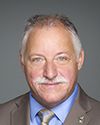Yes, Mr. Chair, thank you. I hope my voice will project in the room.
Mr. Chair and members of the committee, good morning.
I would like to highlight that Captain Navy (Retired) Dr. Cyd Courchesne, who is Veterans Affairs' chief medical officer, and Lieutenant-Colonel (Retired) Dr. Alex Heber, who is Veterans Affairs' chief psychiatrist, are joining me here and providing me backup.
I am very pleased to present you with an update on the efforts of Veterans Affairs to support our veterans and their families.
Mr. Chair, ladies and gentlemen of the committee, I am pleased to be here today to present the current state of our department to the Standing Committee on Veterans Affairs.
Over our history, more than two million Canadians have served our nation in uniform. Today, one in 57 Canadians has served at some time in their lives, and those who serve and veterans are integral members of every community from coast to coast to coast.
Veterans Affairs' role is to provide services and benefits to all military and RCMP veterans, Canadian Armed Forces and RCMP serving members and their families. Currently, we have some 189,000 clients, representing about 18% of Canada's total veteran population.
We also promote recognition and remembrance of the achievements and sacrifices of all those who have served Canada.
Our programming has evolved so that we can better meet the needs of today's veterans. We take a holistic approach to maintaining the health and well-being of veterans over their lifetimes.
More than 90% of our department's budget goes to programs and services directly for veterans and their families. The department ensures that there are always sufficient funds available so that all veterans who have an entitlement receive the benefits and services they need.
To carry out its mandate, the department ensures there are always sufficient funds available so that veterans receive the benefits and services they need.
The majority of our budget is what is regarded as quasi-statutory funding, which means the budget is non-discretionary and based on an annual estimate of veterans' requirements for benefits and services.
We frame our estimates to ensure that we have adequate funds to meet the projected veteran needs and that we stay in the black by a small margin. When we see an increased demand, as we did in the first quarter of last year, we requested and received additional funds. Over the past five years, the trend has been to close the year with just a little bit above the water line. I'm looking at my chief financial officer. These funds are returned to the consolidated revenue fund and then immediately returned to us at the next fiscal year based upon the new forecast of veteran needs.
In other words, regardless of whether 10 or 10,000 veterans apply, they will receive the benefits they need, in accordance with our funding system.
Indeed, more veterans are coming forward requesting support. Since 2015, we have seen an increase of more than 60% of all disability application types and more than 90% in first applications. This increased volume indicates that veterans are more aware of the benefits they need and are entitled to receive for their well-being. Veterans Affairs has responded to the increase in volume by simplifying and consolidating benefits, adding and training staff, integrating various functions and, where possible, digitizing decision-making processes.
We have streamlined the way we make decisions on benefits and programs so that the less complex cases take less time, allowing enhanced and faster consideration of complex cases. We now triage claims for disability benefits. This allows us to expedite applications for those veterans at higher risk.
We have hired hundreds of additional staff, including case managers and others, who work directly with veterans. Additionally, we have hired hundreds to process disability applications and to administer the pension for life benefits, which came into effect on April 1 last year, and veterans can check the wait times for most programs and services on the VAC website. More importantly, they can track the status of their own applications through their online My VAC Account, which now has over 108,000 users.
Our partnership with the Department of National Defence and the Canadian Armed Forces is also helping to improve service delivery. We are working together more and more to reduce complexity of transition, harmonize services, provide clear guidance, integrate case management and provide timely access to benefits and services.
While we've made some progress in dealing with the increased volume, we still have some way to go. We recognize that having a backlog is not in the best interests of our veterans' well-being.
Each year thousands of members leave the forces and undergo a period of transition. About two-thirds of the Canadian Armed Forces members make a smooth transition to life after service. About one-third report that they are not satisfied or have difficulty in their transition.
Our research has found that their difficulties can be centred on one or more of what we call the seven domains of well-being. The well-being framework includes having purpose, financial security, adequate shelter, physical and mental health, family support, integration into the community and pride in their identity.
As such, and to assist in the transition, the department has operationalized several programs with benefits in recent years to align with these domains of well-being. For example, to incentivize releasing members to prepare for civilian life and assist in finding purpose, veterans with at least six years of service may access the new education and training benefit or use the career transition services program to assist in finding civilian employment.
Enhanced family programs recognize those who care for injured veterans. Families of medically released veterans can now access programs at 32 military family resource centres on the Canadian Armed Forces bases.
Suitable housing is key to veterans' well-being. One homeless veteran is indeed one too many.
The veterans emergency fund assists veterans in dire need who are experiencing financial hardship. The department works with local organizations to prevent homelessness, identify veterans at risk, inform them about benefits, and help them find appropriate shelter and treatment.
We are also working closely with Employment and Social Development Canada under the national housing strategy and Canada's homelessness strategy to bolster veteran housing initiatives.
To enable mental well-being, the department ensures that veterans and their family members have the mental health support needed. Veterans Affairs Canada partners with the provinces to fund a network of specialized operational stress injury clinics across the country providing veterans direct access to care. Each clinic provides assessment, treatment, prevention and support to serving Canadian Armed Forces members, RCMP members, and veterans. The clinics work closely with health care providers and organizations in the community to help follow up when needed.
Veterans can access mental health supports even while awaiting a decision on their disability application.
Any veteran, as well as their family, can call Veterans Affairs Canada's assistance service 24 hours per day to speak immediately with a mental health professional.
We understand the important role that families play in supporting our veterans and continue to look at ways and means to support them. Our policy that covers mental health services for family members has remained fundamentally unchanged since 2010. The purpose of providing mental health services to family members is to support the veteran's treatment or rehabilitation toward wellness. Meanwhile, if a family member requires long-term support or mental health treatment for their own mental health condition, Veterans Affairs staff will assist them in locating assistance.
We continue to make strong efforts to prevent suicide. The implementation of the joint Canadian Armed Forces and Veterans Affairs Canada suicide prevention strategy helps reduce risk, build resilience and prevent suicide among our military members and veterans. The department also funds a centre of excellence on PTSD and related mental health conditions. Their research will enhance the knowledge about effective assessment and treatment and will be shared with mental health practitioners across the entire country.
Pride in their service and achievements and remembering the sacrifice of brethren is key to veteran identity and well-being. Our commemoration program is an essential component of the well-being framework.
Last year was very active for commemoration, with the 75th anniversary of the Italian campaign, D-Day, the Battle of Normandy and the Battle of the Scheldt. The year 2019 also saw the fifth anniversary of the end of Canada's military mission in Afghanistan and important progress toward a national monument to commemorate those who served and those who made the ultimate sacrifice.
In 2020, we will also celebrate the 75th anniversary of the end of the Second World War, the liberation of Belgium and the Netherlands, the Battle of the Atlantic, Victory in Europe Day and Victory over Japan Day. We will also celebrate the 70th anniversary of the Korean War and the 105th anniversary of the Second Battle of Ypres in the First World War.
All of these activities serve to strengthen the connection of our distinguished veterans to the youth of Canada, reinforcing the tradition of service in our nation.
Members of the committee, that is a wave-top view of the operations of Veterans Affairs Canada. We face rapidly increasing requests for our services and programs. We've made strides in improving those services and delivering them, yet there's still so much work to be done. I am confident, however, that our folks will exercise this noble responsibility with care, compassion and respect.
Thank you.











